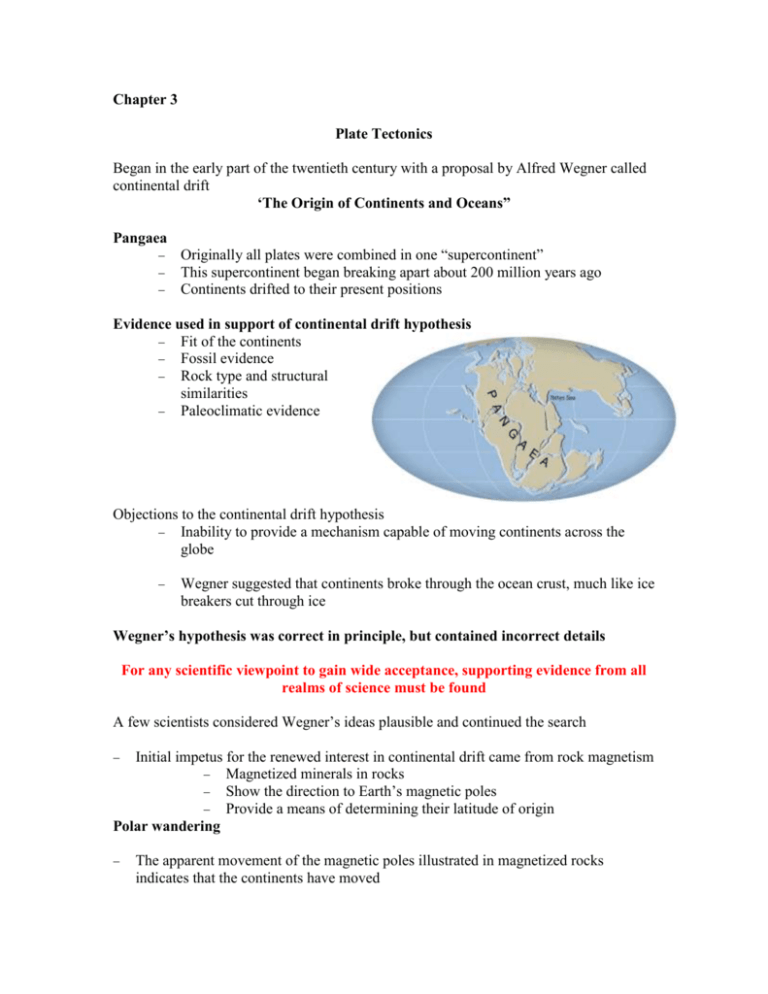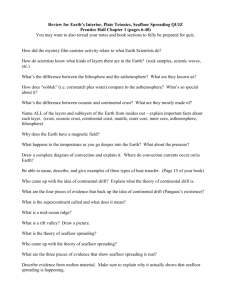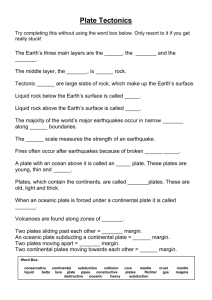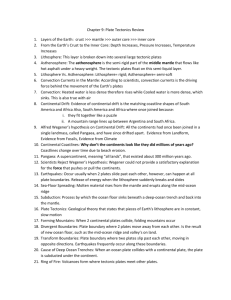Word format - This Old Earth
advertisement

Chapter 3 Plate Tectonics Began in the early part of the twentieth century with a proposal by Alfred Wegner called continental drift ‘The Origin of Continents and Oceans” Pangaea Originally all plates were combined in one “supercontinent” This supercontinent began breaking apart about 200 million years ago Continents drifted to their present positions Evidence used in support of continental drift hypothesis Fit of the continents Fossil evidence Rock type and structural similarities Paleoclimatic evidence Objections to the continental drift hypothesis Inability to provide a mechanism capable of moving continents across the globe Wegner suggested that continents broke through the ocean crust, much like ice breakers cut through ice Wegner’s hypothesis was correct in principle, but contained incorrect details For any scientific viewpoint to gain wide acceptance, supporting evidence from all realms of science must be found A few scientists considered Wegner’s ideas plausible and continued the search Initial impetus for the renewed interest in continental drift came from rock magnetism Magnetized minerals in rocks Show the direction to Earth’s magnetic poles Provide a means of determining their latitude of origin Polar wandering The apparent movement of the magnetic poles illustrated in magnetized rocks indicates that the continents have moved Shows that Europe was much closer to the equator when coal-producing swamps existed Polar wandering curves for North America and Europe have similar paths but are separated by about 24? of longitude Differences between the paths can be reconciled if the continents are placed next to one another During the 1950s and 1960s technological strides permitted extensive mapping of the ocean floor Seafloor spreading hypothesis was proposed by Harry Hess in the early 1960s Geomagnetic reversals Earth's magnetic field periodically reverses polarity – the north magnetic pole becomes the south magnetic pole, and vice versa Geomagnetic reversals are recorded in the ocean crust Dates when the polarity of Earth’s magnetism changed were determined from lava flows In 1963 Fred Vine and D. Matthews tied the discovery of magnetic stripes in the ocean crust near ridges to Hess’s concept of seafloor spreading Paleomagnetism (evidence of past magnetism recorded in the rocks) was the most convincing evidence set forth to support the concepts of continental drift and seafloor spreading Plate Tectonics Much more encompassing theory than continental drift The composite of a variety of ideas that explain the observed motion of Earth’s lithosphere through the mechanisms of subduction and seafloor spreading Earth’s major plates Associated with Earth's strong, rigid outer layer, known as the lithosphere Consists of uppermost mantle and overlying crust Overlies a weaker region in the mantle called the asthenosphere Seven major lithospheric plates The North American South American Pacific African Eurasian Australian Antarctic These are only the major plate there are several more smaller plates Plates are in motion and continually changing in shape and size move relative to each other at a very slow but continuous rate Average about 5 centimeters (2 inches) per year Cooler, denser slabs of oceanic lithosphere descend into the mantle Largest plate is the Pacific plate Several plates include an entire continent plus a large area of seafloor Plate boundaries All major interactions among individual plates occurs along their boundaries Divergent boundary – two plates move apart, resulting in upwelling of material from the mantle to create new seafloor Most are located along the crests of oceanic ridges and can be thought of as constructive plate margins Oceanic ridges and seafloor spreading Along well-developed divergent plate boundaries, the seafloor is elevated forming oceanic ridges Spreading rates and ridge topography Ridge systems exhibit topographic differences Topographic differences are controlled by spreading rates At slow spreading rates (1-5 centimeters per year), a prominent rift valley develops along the ridge crest that is wide (30 to 50 km) and deep (1500-3000 meters) At intermediate spreading rates (5-9 centimeters per year), rift valleys that develop are shallow with subdued topography At spreading rates greater than 9 centimeters per year no median rift valley develops and these areas are usually narrow and extensively faulted Convergent boundary – two plates move together with subduction of oceanic plates or collision of two continental plates Older portions of oceanic plates are returned to the mantle in these destructive plate margins Surface expression of the descending plate is an ocean trench Called subduction zones *Average angle at which oceanic lithosphere descends into the mantle is about 45? Types of convergent boundaries Oceanic-continental convergence Denser oceanic slab sinks into the asthenosphere As the plate descends, partial melting of mantle rock generates magmas having a basaltic or, occasionally andesitic composition Mountains produced in part by volcanic activity associated with subduction of oceanic lithosphere are called continental volcanic arcs (Andes and Cascades) Oceanic-oceanic convergence When two oceanic slabs converge, one descends beneath the other Often forms volcanoes on the ocean floor If the volcanoes emerge as islands, a volcanic island arc is formed (Japan, Aleutian islands, Tonga islands) Continental-continental convergence Continued subduction can bring two continents together Less dense, buoyant continental lithosphere does not subduct Result is a collision between two continental blocks Process produces mountains (Himalayas, Alps, Appalachians) Producing the Himalayas Transform boundaries - located where plates grind past each other without either generating new lithosphere or consuming old lithosphere Most join two segments of a mid-ocean ridge as parts of prominent linear breaks in the oceanic crust known as fracture zones A few (the San Andreas fault and the Alpine fault of New Zealand) cut through continental crust Changing boundaries - new plate boundaries are created in response to changes in the forces acting on the lithosphere







